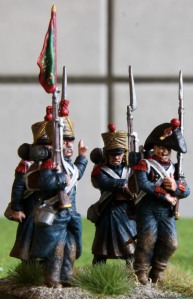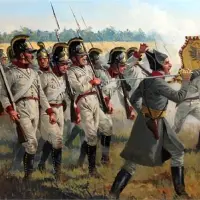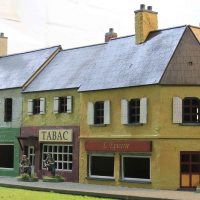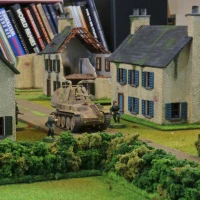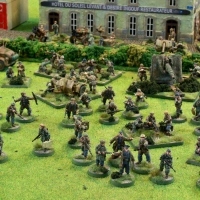While these were actually painted in February, I only got around to basing and photographing these guys now. Some of you might ask why I am painting Austrian Jäger right now, while I am in the middle of doing Prussians and French for my Möckern project and why I only painted four instead of a whole unit. Well they are for my Möckern project.
When looking at the first day actions at Leipzig, most people perceive the Prussian avant-garde to be on the flank of the allied units, but this is only partly true. In a tactical sense they were with their right flank hinging on the swampy terrain formed by the myriad of rivers and creeks near Möckern. But in a strategic sense they were not since there were the Austrians to their right behind said swamp. Now the allied plans called for some Austrian units to move through said swamp to surprise the French, which was a failure, since they did not know their way and their local guides were anything but local. Prussian after action report about the battle at Möckern all talk about a unit of Östereichische Jäger, roughly company sized, appearing in the Prussian rear shortly before the assaults began. While none of the reports mention the unit they came from, most say that they were separated from their parent formation and got lost in the swamps. Technically this faced the Prussians with a problem. They did not have the resources and time to get them back to their parent formation and indeed they even lacked the knowledge where exactly those Austrians were supposed to be. So they offered the Austrians a choice. They could sit things out behind Prussian lines till the evening or the next day when the Prussians would try to march them “home” or while they were here, they could join the Prussians in the assault. The Austrians chose the later and were attached to the 4th battalion of the 15te Schlesische Landwehr for the day.
Now choosing minis became my first problem. Believe it or not… There seem to be few companies doing Austrian Jäger, the best choices I found were Foundry and Front Rank. Since Foundry Austrians generally are pretty small, I went for Front Rank. While those might seem large when compared to Victrix and Perry, which eventually will make up the bulk of my Austrians, it will not be so bad to make them stand out when placed in separate units. But they will look good when mixed within a unit of my Prussian Landwehr by Calpe.
The bigger problem was their uniform colour. Most illustrations you find differ in colour… and by a large deal at that. The official colour was called a light Hechtgrau, which references to the fish pike. You get anything from light grey to virtual slate greys. The best reference I found was for a Tyrolian Jäger in the Lützower Freikorps. While Prussian the uniform was greatly inspired by the Austrians, but I did not want to settle with this.
So I did what every good wargamer does. I asked around. The most valuable information came form Iannick (aka. Archiduke Charles on most fora) who pointed me a great study on his own blog. There I found out, that Hechtgrau actually refered to a light blue-greenish grey, which was even lighter than the one shown in the above painting. But I have to admit, that the colours proposed, although without doubt correct, were a though too blue for my taste. But the advantage of having a couple hundred colours is, you just need to move a bottle to the left (I arrange the darker colours to the left in my cart) and you have what you want. So in the end I used Dark Blue Grey (VAL 904) highlighted with Blue Grey Pale (VAL 905). And I am more than happy with the result. I would also like to express my thanks to Jason (aka Der Feldmarschall) for providing me with photos of Austrian Jäger equipment, which helped a lot with the details.)
The minis themselves were a joy to paint, and from a sculpting point of view I was more than impressed by the quality and detail on these Front Ranks. The only gripe I had was, that these minis were actually quiet boring with their grey uniforms and black belting. Unfortunately, Front Rank created them without Brotbeutel, which would have added a little touch of white, but if this is my only complaint, I think I should really shut up and show you some pictures!






















































